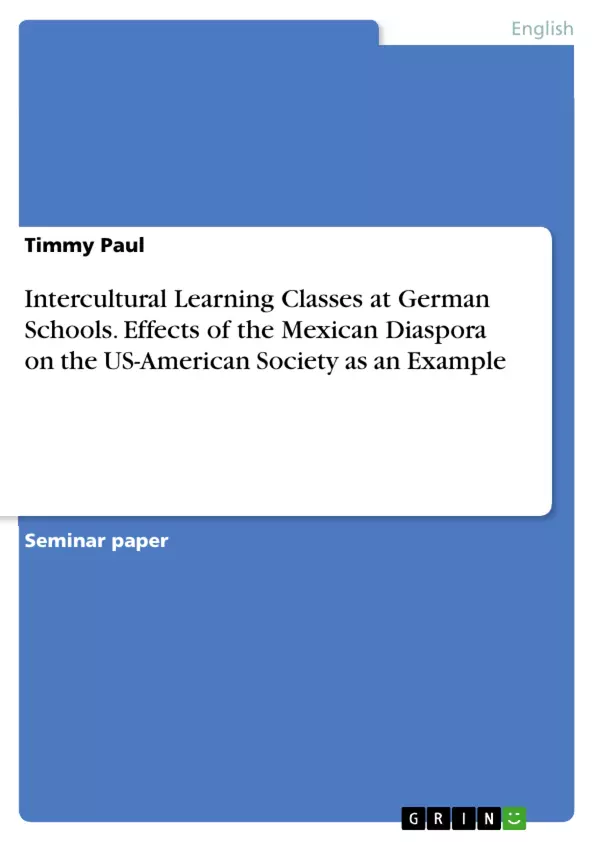This text examines the effects of the Mexican Diaspora on the US American society as a complex example in intercultural learning classes at german schools. What can we as teachers learn from the situation in the United States and what can we do to avoid such in Europe and Germany? In my view it is possible to convey students that early arrangements of integration can support the social peace and the mutual acceptance within multiethnic societies through information about the diverse problems of strong Mexican parallel societies in the US. In the following I am going to conduct an objective clarification of the important matters which influenced today's situation in the United States.
Therefore, I will examine the historical development of the Mexican American relationship beginning with the end of the Mexican American War in 1848, the economic effects on Mexican migrants and the United States, the mutual prejudice, and the integrational efforts. During the further procedure I want to focus on how teachers in Germany can prevent a situation like the US has to face it currently. „If you meet the criteria, you can come out of the shadow and get right with the law. If you are a criminal, you will be deported. If you plan to enter the U.S. illegally, your chances of getting caught and sent back just went up.“ President of the United States Barack Obama used these words in his speech about the problems of the immigration system of his country. The goal of his speech was to convince the citizens of the United States of his plan to legalize the status of about five million illegal immigrants, taking into account some specific conditions.
This offer counts mainly for parents who live illegally in the US but have children with US-citizenships or who have a work permission and live there since at least five years. It also counts for people who migrated illegally as children to the United States. Obama wants to enforce this primarily to get these people 'out of the shadows' and thereby out of criminality. Furthermore, he wants to free the illegal migrants from the omnipresent fear of being deported. But the point is, like Obama said in his speech, due to the fact that illegal migrants have to stay in the shadows of their society, parallel societies arise and split the people of a country, like it already happened in the United States.
Inhaltsverzeichnis (Table of Contents)
- Introduction
- Objective Clarification
- Historical Development of the Mexican-US-Migration
- Economical Advantages
- For the Mexican Immigrants
- For the United States
- Mutual Prejudice
- Mexican Prejudice against the United States
- US-American Prejudice against Mexican Migrants
- Integrational Efforts
- Didactical Consideration
- Conclusion
Zielsetzung und Themenschwerpunkte (Objectives and Key Themes)
The aim of this paper is to examine the effects of the Mexican diaspora on the US-American society, highlighting its significance as a complex example for intercultural learning in German schools. The paper analyzes the historical development of Mexican migration to the US, its economic implications for both Mexican immigrants and the US, the mutual prejudice between the two groups, and the efforts toward integration.
- Historical development of Mexican migration to the US
- Economic impacts of migration on both Mexico and the US
- Mutual prejudice and cultural tensions between Mexicans and Americans
- Integration efforts and challenges faced by Mexican immigrants in the US
- The implications of the Mexican diaspora for intercultural learning in German schools
Zusammenfassung der Kapitel (Chapter Summaries)
The introduction sets the context by discussing President Obama's speech on immigration reform and its implications for illegal immigrants. The paper then introduces the objective of examining the historical development of Mexican-US relations, focusing on the economic effects on both migrants and the US, mutual prejudice, and integration efforts.
The first chapter delves into the historical development of Mexican migration to the US, beginning with the end of the Mexican-American War in 1848. It examines the fluctuating rates of migration throughout the 20th century, including the impact of the Mexican Revolution, the Great Depression, and the Bracero program. The chapter concludes by highlighting the growth of permanent migration and the rise of illegal immigration in the 1970s.
The second chapter focuses on the economic advantages of migration, examining both the benefits for Mexican immigrants and the US. It explores the push-and-pull factors that motivate migration, such as the desire for a higher standard of living and economic opportunities. The chapter also discusses the demand for low-skilled labor in the US and the impact of globalization on wages.
Schlüsselwörter (Keywords)
The main keywords and focus topics of this paper are: Mexican diaspora, US-American society, intercultural learning, historical development, economic effects, mutual prejudice, integration efforts, parallel societies, push-and-pull factors, transnational communities, Bracero program, Immigration Reform and Control Act, globalization, low-skilled labor.
- Quote paper
- M.Ed. Timmy Paul (Author), 2015, Intercultural Learning Classes at German Schools. Effects of the Mexican Diaspora on the US-American Society as an Example, Munich, GRIN Verlag, https://www.grin.com/document/1301076



